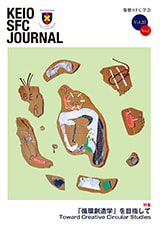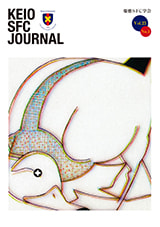- HOME
- KEIO SFC JOURNAL
- Vol.23 No.2

Toward Creative Circular Studies
-
Foreword
Download this article (PDF):SFCJ-23-2-00.pdfHiroya Tanaka (Professor, Faculty of Information and Environmental Studies, Keio University) Sachiko Tsukahara (Associate Professor, Faculty of Environment and Information Studies, Keio University)
-
Extinguishable Garbage Disposal Container “Chiero” and Comprehensive Analysis of Its Microbial Flora
Nobuo Matsumoto (Representative, Chiero Hayama) Rie Hirano (Administrator, GomiFes 532 (Gominity)) Huang Ying (KLL Postdoctoral Researcher, Keio Leading-edge Laboratory of Science and Technology) Kenji Miyamoto (Professor, Faculty of Science and Technology, Keio University) The earth has entered an era of scorching heat from global warming, necessitating drastic measures to combat climate change. Under such circumstances, it is essential to separate the waste we generate and recycle what can be used. On the other hand, approximately 40% of the waste that is incinerated is food waste, which contains a lot of water and therefore requires a lot of energy to incinerate. Therefore, if each household can dispose of food waste, it is considered an effective solution for reducing energy and carbon dioxide emissions. Therefore, Chiero, which uses microorganisms to eliminate food waste, is expected to be a trump card to solve the food waste problem.
Download this article (PDF):SFCJ-23-2-01.pdf -
Identifying the Effects of Relationship-Oriented Local Currency Use on Subjective Well-Being ―Focusing on Users’ Money Perspectives, Nature Connectedness, and Place Attachment
Toshiyuki Yasui (Professor & Dean, Department of Social System Design, Eikei University of Hiroshima) Takahiko Sueyoshi (CEO, Koozyt, Inc.) Hiroyuki Egami (CEO, URUU Co., Ltd.) Makiko Takao (Professor, Graduate School of Regional Policy Design, Hosei University) This study is to identify how users of relationship-oriented local currencies, which promote relationships among local residents, change their subjective well-being before and after their use, focusing on the relationship between their views of money, their nature connectedness, and their place attachment to the community. Using a relationship-oriented local currency platform in Kamakura City, Kanagawa Prefecture, as the empirical field, the authors unveiled that the use of such relationship-oriented local currency significantly improved short-term well-being and, to certain extent long-term well-being, regardless of the incentives given for their use. They further found that certain financial views had a negative impact on users’ well-being, while nature connectedness and place attachment were found to be closely linked to well-being.
Download this article (PDF):SFCJ-23-2-02.pdf -
Local Plastic Recycling Using Large Scale Pellet-Based 3D Printers
Hiroya Tanaka (Professor, Faculty of Information and Environmental Studies, Keio University) Ryohei Yuasa (Project Assistant Professor, Graduate School of Media and Governance, Keio University) Masaki Arai (Project Research Associate, Graduate School of Media and Governance, Keio University) Takumi Moriya (Project Researcher, Graduate School of Media and Governance, Keio University) Takuji Tokiwa (Project Professor, Graduate School of Media and Governance, Keio University) Mayumi Aoki (Project Research Associate, Graduate School of Media and Governance, Keio University) Emu Masuyama (Associate Professor, School of Project Design, Miyagi University / Senior Researcher, Keio Research Institute at SFC) Seiichi Yuyama (CEO, S.lab Inc. / Researcher, Keio Research Institute at SFC) Kazuko Tachibana (S.lab Inc. / Researcher, Keio Research Institute at SFC) Shotaro Kamai (S.lab Inc. / Researcher, Keio Research Institute at SFC) Akihito Takahashi (Hoden Seimitsu Kako Kenkyusho Co., Ltd. / Researcher, Keio Research Institute at SFC) Large pellet 3D printers will become a core technology for local plastic recycling. The authors are implementing locally in Kamakura City, the technology system originally developed for the Tokyo 2020 Olympic and Paralympic Games. This paper identifies its possibilities and challenges and summarizes future directions.
Download this article (PDF):SFCJ-23-2-03.pdf -
An Architecture for Fine-grained Real-time Sensing of Household Waste Emission
Jin Nakazawa (Professor, Faculty of Environment and Information Studies, Keio University) Yin Chen (Associate Professor, Reitaku University) Wenhao Huang (Doctoral Program, Graduate School of Media and Governance, Keio University) Kazuhiro Mikami (Doctoral Program, Graduate School of Media and Governance, Keio University) We propose a real-time sensing architecture that converts household waste emissions into fine-grained data, and report on demonstrations in the cities of Kamakura, Yokosuka, and Fujisawa in Kanagawa Prefecture. The architecture utilizes images from the rear camera of a garbage truck to detect and count garbage bags using deep learning technology, and can determine the collection point and collection time for each bag. This enables real-time understanding and visualization of the amount of household garbage discharged, and enables data-based studies for the temporal and spatial optimization of collection operations. Looking ahead, we will work to expand the technology for weighing various types of refuse and resources and to improve scalability, aiming to complete the technology by 2025.
Download this article (PDF):SFCJ-23-2-04.pdf -
Barriers to the Circular Economy in Japan
Sachiko Tsukahara (Associate Professor, Faculty of Environment and Information Studies, Keio University) The transition from a linear economy based on the consumption of natural resources to a Circular Economy that maintains and restores natural capital while sustaining human well-being is a major global policy trend. In Japan, a CE-related government vision has also been launched, raising expectations for establishing CE-based business models and generating co-creation platforms by industry, government, academia, and local citizens. The academia is at a point where it is required to identify barriers to the CE transition and discuss structural issues in Japan. This paper attempts to identify Japan-specific CE barriers through a domestic literature review and interviews, with reference to CE barrier studies mainly in Europe, and analyses the issues and highlights the role of policy.
Download this article (PDF):SFCJ-23-2-05.pdf -
Architecture as a Circular Hub ―A Proposal of Next Circular Model: Vortex Economy®
Taiki Sato (Manager, Taisei Corporation, Advanced Center of Technology) Kanako Hasumi (Manager, Taisei Corporation, Advanced Center of Technology) Ryo Deguchi (Senior Architect, TAISEI DESIGN Planners Architects & Engineers) Osamu Furuichi (Chief Manager, TAISEI DESIGN Planners Architects & Engineers) In construction field, general contractors team up with various specialized companies and connect their roles to construct buildings and infrastructures. Due to this business process, there is a possibility that the general contractor has an ability to realize a new material circulation by using architecture as a hub. In this report we propose next circular economic model: Vortex economy, where resources circulate across sectors and industry. As a precedent case study, we considered the role of architecture in the wood circulation. Furthermore, the necessary appropriate state of architecture was discussed.
Download this article (PDF):SFCJ-23-2-06.pdf -
Can Our Stocked Material Be Passed on as an Asset to the Next Generation? ―The Challenge of Establishing a Stock-Type Society
Hiroki Tanikawa (Professor, Graduate School of Environmental Studies, Nagoya University) Can Japan’s material stock be left as an asset for future generations? Climate change, declining birth rates, and an aging society are already underway. We are getting ready to plan for society in 2050, which was thought to be a distant future. This article summarizes the concept of a stock-type society that accumulates many assets that will enrich the next generation. It discusses establishing a stock-type society from many perspectives based on existing research.
Download this article (PDF):SFCJ-23-2-07.pdf
[Review articles]
[Research articles]
[Review articles]
[Research articles]
[Research articles]
[Review articles]
[Review articles]]
-
Idiosyncrasies of the Japanese AI Principles in Relation to International Issues and Principles ―Policy Implications for Possible Future Review of Them
Kimie Hatakeyama (Project Research Associate (Non-tenured), Graduate School of Media and Governance, Keio University) Hajime Oiso (Senior Researcher, Keio Research Institute at SFC) Various public and private organizations have published so called ‘AI principles’ i.e. non-binding guidelines to address new issues relevant to AI. There are both views that rough consensus exists across principles on the types of their items and that such consensus is only superficial. This study mainly makes an international comparison on the principles issued by MIC of the government of Japan using the analysis released by CAHAI of Council of Europe, and shows that even items that appear to be identical, some of them, such as emergency preparedness including national security and sustainability, have differences in contents between Japan and the rest of the world. Addressing the differences while disseminating Japan’s uniqueness could be a future issue.
Download this article (PDF):SFCJ-23-2-08.pdf -
Autobiographical Narrative on the Identity Conflict and Transformation of a Korean Researcher
Seo Eunyoung (Doctoral Program, Graduate School of Media and Governance, Keio University) Through this article, the author, who is a Korean immigrant in Japan, examined the process of conflict and reconciliation between her multiple identities. Having experienced an identity conflict between the self which was represented by macroscopic discourses such as history, politics, and ethnic culture, and the self which was founded by herself, the author was able to answer questions about her own identity through personal and microscopic narratives. When recognizing the individual and small narratives, it was confirmed that the binary confrontational relationship between majority and minority, and between Japanese and immigrants were resolved. And a safe and new space based on “sameness” was created. Through the knowledge gained from the author’s own experience, she tried to provide a new perspective on immigration-related research in Japan.
Download this article (PDF):SFCJ-23-2-09.pdf

